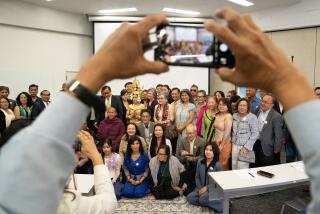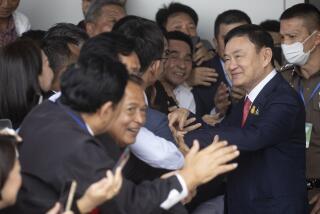Cambodiaâs Parliament Meets at Last : Asia: Members name Sihanouk head of state. But threat of a breakaway state is in the air.
PHNOM PENH, Cambodia â A year and a half after the signing of a peace agreement designed to end the civil war in Cambodia, the first freely elected Parliament in decades convened Monday, but the historic moment was overshadowed by threats of secession, political upheaval and renewed violence.
In a simple concrete building topped by a slanting roof of saffron-colored tiles, members of the Constituent Assembly chosen in U.N.-supervised elections last month took their seats next to political foes for the first time in years.
Hun Sen, prime minister of the Phnom Penh regime, sat in a third-row seat that, according to the alphabetical order of the members, placed him next to Ieng Mouly, a leader of the opposition Buddhist Liberal Democratic Party who fought the Phnom Penh government for 14 years.
Empty seats scattered around the small hall, traditional home of Cambodiaâs National Assembly, bore testimony to a threat by dissident elements of the Phnom Penh government to set up a breakaway state in seven provinces of eastern Cambodia.
The Phnom Penh regime, which finished second in the election behind the opposition royalist party known as FUNCINPEC, has refused to accept the election results. But its leaders have agreed to take part in the initial work of the assembly while pressing demands for an investigation into alleged voting irregularities.
âYour presence here is a clear affirmation of democracy in Cambodia and of the unmistakable will of the people to become the master of their own country,â said Yasushi Akashi, head of the U.N. peacekeeping operation that organized the elections.
Under the 1991 peace agreement, the assembly has three months to draft a constitution and then select a new government.
As its first order of business, the assembly named Prince Norodom Sihanouk as the countryâs head of state, a position he was holding on a temporary basis. The key figure in Cambodiaâs history for the last 50 years, Sihanouk was overthrown in a coup by the countryâs National Assembly in 1970.
Sihanouk tried to form a coalition government last week in which the Phnom Penh regime would share power equally with the FUNCINPEC party. He angrily dropped the plan after his son, FUNCINPEC leader Prince Norodom Ranariddh, complained that this government did not reflect his partyâs victory at the polls.
Sihanouk appealed to all Cambodian factions to work for national unity and end the partition of the country. In part, the appeal was aimed at the Khmer Rouge, the Maoist guerrillas who backed out of the peace agreement last year and opposed the elections. The guerrillas have established their own zone in western Cambodia and remain the single largest threat to the peace accords.
But Sihanoukâs words were also clearly intended for one of his other sons, Prince Norodom Chakrapong, who is leading the secessionist movement to protest the election results and who resigned his seat in the new Parliament.
Chakrapong said Saturday that his supporters were establishing an âautonomous zoneâ in seven eastern provinces near Vietnam. He ordered U.N. forces to leave the zone. Chakrapong is a deputy prime minister in the Phnom Penh regime, and his actions are widely believed to have carried the governmentâs blessing, which the government denies.
By refusing to accept the election results and raising the threat of violence in the breakaway provinces, the regime is apparently hoping to bring pressure to bear on Prince Ranariddh to accept power-sharing on an equal footing.
More to Read
Sign up for Essential California
The most important California stories and recommendations in your inbox every morning.
You may occasionally receive promotional content from the Los Angeles Times.










